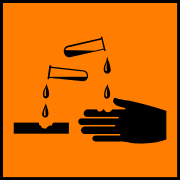Standard level
This section examines the Brønsted Lowry theory of acids and bases, a theory which extends the traditional Arrhenius definitions of acids.
Syllabus ref: R3.1.1Reactivity 3.1.1 - Brønsted–Lowry acid is a proton donor and a Brønsted–Lowry base is a proton acceptor.
- Deduce the Brønsted–Lowry acid and base in a reaction.
Guidance
- A proton in aqueous solution can be represented as both H+(aq) and H3O+(aq).
- The distinction between the terms “base” and “alkali” should be understood.
Tools and links
- Nature of science, Reactivity 3.4 - Why has the definition of acid evolved over time?

Brønsted-Lowry
The Arrhenius theory of acids is based on the idea of the behaviour of hydrogen ions in aqueous solution. This was extended by Brønsted and Lowry to include hydrogen ions - protons in any system aqueous or otherwise. They defined acid behaviour as the donation of a proton (hydrogen ion) and base behaviour as acceptance of a proton.
Notice that this does not exclude Arrhenius, it merely extends the idea of acidity to cover non-aquous systems.
Applying Brønsted - Lowry theory to normal acid base reactions, we see that an acid is the species donating the hydrogen ion and the base is the species accepting the hydrogen ion in the aqueous system. Hence Arrhenius' theory of aqueous acidity is encompassed by that of Brønsted and Lowry.
CH3COOH + OH- → CH3COO- + H2O
In this example, the ethanoic acid is donating the proton (hydrogen ion) and the hydroxide ion (base) is accepting it. Ethanoic acid is behaving as an acid according to both Arrhenius and Brønsted-Lowry.
Although this is a rather trivial example, it serves to highlight the fact that the Brønsted-Lowry theory is just and extension of Arrhenius theory. Where it is useful is in its application to non-aqueous systems, where Arrhenius' cannot be applied.
|
Example: In the reaction between ammonia gas and hydrogen chloride the hydrogen chloride transfers a hydrogen ion to the ammonia making an ammonium ion. In this reaction the ammonia is behaving as a Brønsted Lowry base by accepting a proton (hydrogen ion). The hydrogen chloride is a Brønsted-Lowry acid for providing (donating) that proton (hydrogen ion). HCl + NH3 → NH4Cl |
Any system where hydrogen ions are transferred can be considered according to the Brønsted Lowry definition of acids and bases.
Brønsted-Lowry acids
In order to consider the possibility of a substance behaving as a Brønsted-Lowry acid or base you must consider the possibility of it accepting or donating hydrogen ions.
The species under consideration must have a hydrogen atom that is capable of being detached as a hydrogen ion.
NH4+ can behave as a Brønsted-Lowry acid as it can lose an H+ and become NH3.
Brønsted-Lowry bases
These must be capable of accepting a hydrogen ion into the structure.
In the reaction between sulfuric acid and nitric acid, the sulfuric acid donates a proton to one of the oxygens of the nitric acid. It is the first stage of formation of the nitronium ion NO2+
In this reaction sulfuric acid is behaving as a Brønsted-Lowry acid and the nitric acid is a Brønsted-Lowry base.
H2SO4 + HNO3 → [H2NO3]+ + HSO4-
[H2NO3]+ → H2O + NO2+